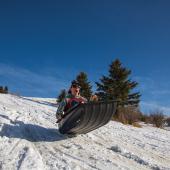The Hole Shebang
Montana. To fishermen around the globe this word conjures images of rising trout, endless riffles, drag-free drifts, and spectacular mountain scenery. And while the trout probably rise as we speak and the riffles continue to run endlessly, there is, in fact, a bit more to the story.
Montana fishing isn’t just about delicately presenting an elk-hair caddis to a Madison River brown, or firing hoppers to cutthroats on the banks of the Yellowstone. Indeed, some of the best angling opportunities involve a much different and considerably less romantic approach: maggots, jigs, five-gallon buckets, and a hole in the ice.
That’s right, we’re talking about ice fishing and the season is here. It’s time to pack away the Royal Wulffs and graphite wands, and pull out the short rod and Swedish Pimple. Time to exchange the sandals for wool socks, and the short-sleeve shirt for the old snowmobile suit. Time to plant your butt on the cold, hard ice.
Now we all know that skiing, sledding, skating, sleeping, and reading seem like much saner ways of spending an afternoon, rather than staring for hours through a hole in a frozen lake. Well, the fact that sanity isn’t our topic of discussion allows us to concentrate on more important matters, such as fish. Perch, trout, ling, walleye, pike, carp – virtually anything that swims can be caught through the ice, and often in much greater numbers than at any other time of the year.
Couple that with a sport that is inexpensive, extremely social, that requires little skill and no taste for fashion, and you’ve got a winner. Ice fishing is for everybody, as all-American as cheeseburger pie. Getting started is easy and begins with a serious pair of warm boots.
Once fitted in your boots and every other warm article of clothing you can dig out of the closet, it’s time to consider other necessary gear for a successful hardwater adventure. Most ice fishermen carry at least two rods. The most popular models are short (2-3 feet), designed to let anglers sit close to the hole, and are fitted with a spinning reel and matching line. You’ll also need a tool for digging through the ice; hand- and gas-powered augers are common, though spud bars, axes, and chain saws will work.
Other basic necessities include a hole skimmer, crampons, bucket, knife, clip-on lead depth finder, and an assortment of bobbers, jigs, and hooks, the sizes and styles of which are determined by the species of fish you’re after.
Having acquired the basic equipment, the ice fisherman must decide which fishing method suits his or her style best. The first and most straightforward is the five-gallon bucket technique. This method consists of stuffing all of your gear into a bucket, dragging it out onto the ice and then using it as a seat once you’ve reached the honey hole. Though exposed to the elements, the bucket angler is mobile. This can often be a key to success, as fish may congregate in different areas of the lake. And two buckets, of course, are better than one.
The shanty method is quite popular and the most widely recognized ice fishing approach. Basically just a plywood shack built on skis, the shanty can be equipped with woodstove, couch, VCR and TV, making it the perfect escape from reality and a great place to drink beer and watch the Superbowl. Super-motivated shanty anglers sometimes even drill holes and wet their lines. If you’re unfamiliar with this method, visualize fishing through a hole in the floor of your garage.
Last but not least is the truck technique. This is far and away the best way I’ve learned of getting rid of a perfectly good truck. Truck anglers drive to their spot on the ice to save the ten-minute walk. Advantages over the bucket routine are many, however, and so could be worth risking the family roadster. Warmth, storage, and AM radio are just a few of the benefits of fishing from your truck.
So, having geared up and chosen a suitable method, you must now determine which species of fish will be the target of your relentless ice fishing assault.
Trout and perch, the two most popular gamefish in our area, are zealots for the jig-and-maggot combo. Chartreuse, white, and pink are all productive jig colors. Fish larger marabou jigs for trout just under the ice, while probing for perch with teardrop jigs just a foot or two off the bottom. Slip-bobber rigs are popular and very effective.
Ling – bottom dwelling, serpentlike members of the cod family – are also a popular game species, mainly for their size and culinary possibilities. Dubbed "lawyer fish" by many due to their thick layer of slime, ling are nocturnal feeders, and thus are frequently caught by the more dedicated nighttime nglers. Perch belly meat, rigged on a large Swedish Pimple or glow-in-the-dark jig, works well when fished just a few inches off the bottom.
Though some prefer to give their baits action by jigging them or using a slow retrieve, still-fishing works well too. Just let ‘em sit and wait for a bite. Simplicity. That’s the name of the game, and in today’s world of technological stress, ice fishing offers a welcome reprieve. But watch out – addiction is easy. That somewhat foreign block of ice you’ve alienated for years could suddenly become home.
Popular destinations in the Bozeman area include Canyon Ferry, Dailey Lake, Hyalite Reservoir, Hebgen Lake, Harrison Lake, and Clark Canyon Reservoir. See map to the left for the location of above lakes. Check local tackle shops for current regulations, ice safety, and the latest fishing reports.










